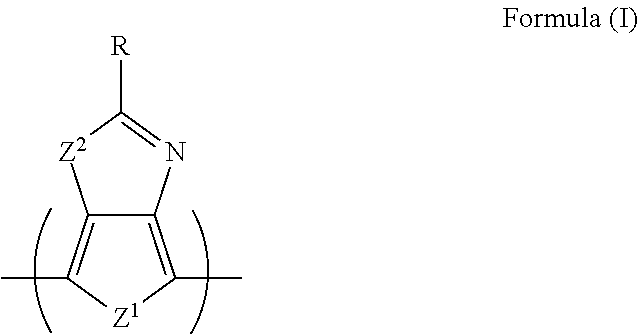Organic semiconductor polymer, composition for organic semiconductor material, and photovoltaic cell
a semiconductor and organic technology, applied in the direction of non-metal conductors, thermoelectric devices, conductors, etc., can solve the problems of insufficient insufficient durability of polymers, and insufficient photoelectric conversion efficiency of organic thin film solar cells, etc., to achieve excellent durability, less uneven film thickness, and excellent photoelectric conversion efficiency
- Summary
- Abstract
- Description
- Claims
- Application Information
AI Technical Summary
Benefits of technology
Problems solved by technology
Method used
Image
Examples
examples
[0131]The present invention will be described in more detail based on the following examples. The materials, used amounts, proportions, treatments, treatment procedures and the like indicated in the following Examples can be appropriately modified as long as the purport of the present invention is maintained. It is therefore understood that the present invention is by no means intended to be limited to the specific examples below.
experiment 1
Synthesis of Polymer 1
[0132]Synthesis was carried out as shown in Scheme 1 described below.
(Synthesis of Intermediate 2)
[0133]111.3 g of Compound 1 and 38.1 g of thiourea were added to 250 ml of ethanol, and the mixture was heated to reflux for 2 hours. The reaction liquid was poured into ice water, and a 10% aqueous solution of sodium hydroxide was added thereto until the reaction liquid turned weakly alkaline. The mixture was extracted with ethyl acetate. The extract was washed with a saturated aqueous solution of sodium hydrogen carbonate and saturated brine, and then was dried over anhydrous magnesium sulfate. After filtration, the solvent was distilled off under reduced pressure, and the residue was crystallized from an ethyl acetate / hexane mixed solvent. Thus, 100.2 g of an intermediate 2 was obtained. Yield: 82.0%.
(Synthesis of Intermediate 3)
[0134]56.5 g of copper (II) chloride was added to 1 L of acetonitrile, and 44.5 g of isoamyl nitrite was added thereto at room temperat...
experiment 2
Synthesis of Polymer 2
[0147]Synthesis was carried out as shown in Scheme 2 described below. An intermediate 14 was synthesized by the same technique as in Experiment 1.
(Synthesis of Polymer 2)
[0148]In a nitrogen atmosphere, 60.0 mg of magnesium fragments were introduced into 50 ml of dry THF, and a solution prepared by dissolving 91.9 mg of the intermediate 14 in 10 ml of dry THF was slowly added dropwise thereto. While the state in which fine foaming from magnesium was sustained was maintained, dropwise addition of the solution of the intermediate 14 was continued. After completion of the dropwise addition, the mixture was further stirred for one hour at 50° C. The mixture was left to cool naturally, and then this solution was taken out with a syringe and was added to a suspension prepared by dispersing 50 mg of (1,3-bis(diphenylphosphino)propane)nickel chloride in 20 ml of dry THF. This mixture was heated to 50° C., and was allowed to react for 10 hours. After the reaction mixture...
PUM
| Property | Measurement | Unit |
|---|---|---|
| wavelengths | aaaaa | aaaaa |
| HOMO | aaaaa | aaaaa |
| energy level | aaaaa | aaaaa |
Abstract
Description
Claims
Application Information
 Login to View More
Login to View More - R&D Engineer
- R&D Manager
- IP Professional
- Industry Leading Data Capabilities
- Powerful AI technology
- Patent DNA Extraction
Browse by: Latest US Patents, China's latest patents, Technical Efficacy Thesaurus, Application Domain, Technology Topic, Popular Technical Reports.
© 2024 PatSnap. All rights reserved.Legal|Privacy policy|Modern Slavery Act Transparency Statement|Sitemap|About US| Contact US: help@patsnap.com










